Effective Management of Employee Behaviour: Challenges & Solutions
VerifiedAdded on 2023/06/11
|9
|2050
|428
Report
AI Summary
This report examines the challenges modern organizations face in managing employee behavior, focusing on issues like stereotyping, lack of communication, demotivation, and unresolved conflicts. It highlights the impact of globalization and the increasing need for diversity policies to address discrimination. The report recommends implementing diversity and motivation policies, establishing effective communication channels, accepting individual differences, and proactively managing conflicts to create a positive work environment. By addressing these challenges, organizations can improve employee satisfaction, enhance performance, and gain a competitive advantage. Desklib provides access to similar solved assignments.

0 | P a g e
Employee Behaviour
Employee Behaviour
Paraphrase This Document
Need a fresh take? Get an instant paraphrase of this document with our AI Paraphraser

TABLE OF CONTENTS
Introduction....................................................................................................................................................... 2
Challenges in Managing Employee Behaviour..................................................................................... 3
Recommendations to address the Challenges...................................................................................... 5
Diversity Policies.............................................................................................................................. 5
Motivation Policies.......................................................................................................................... 5
Communication Channels............................................................................................................ 5
Accepting the Differences............................................................................................................ 5
Conflict Management..................................................................................................................... 5
Conclusion........................................................................................................................................................... 7
References........................................................................................................................................................... 8
Introduction....................................................................................................................................................... 2
Challenges in Managing Employee Behaviour..................................................................................... 3
Recommendations to address the Challenges...................................................................................... 5
Diversity Policies.............................................................................................................................. 5
Motivation Policies.......................................................................................................................... 5
Communication Channels............................................................................................................ 5
Accepting the Differences............................................................................................................ 5
Conflict Management..................................................................................................................... 5
Conclusion........................................................................................................................................................... 7
References........................................................................................................................................................... 8
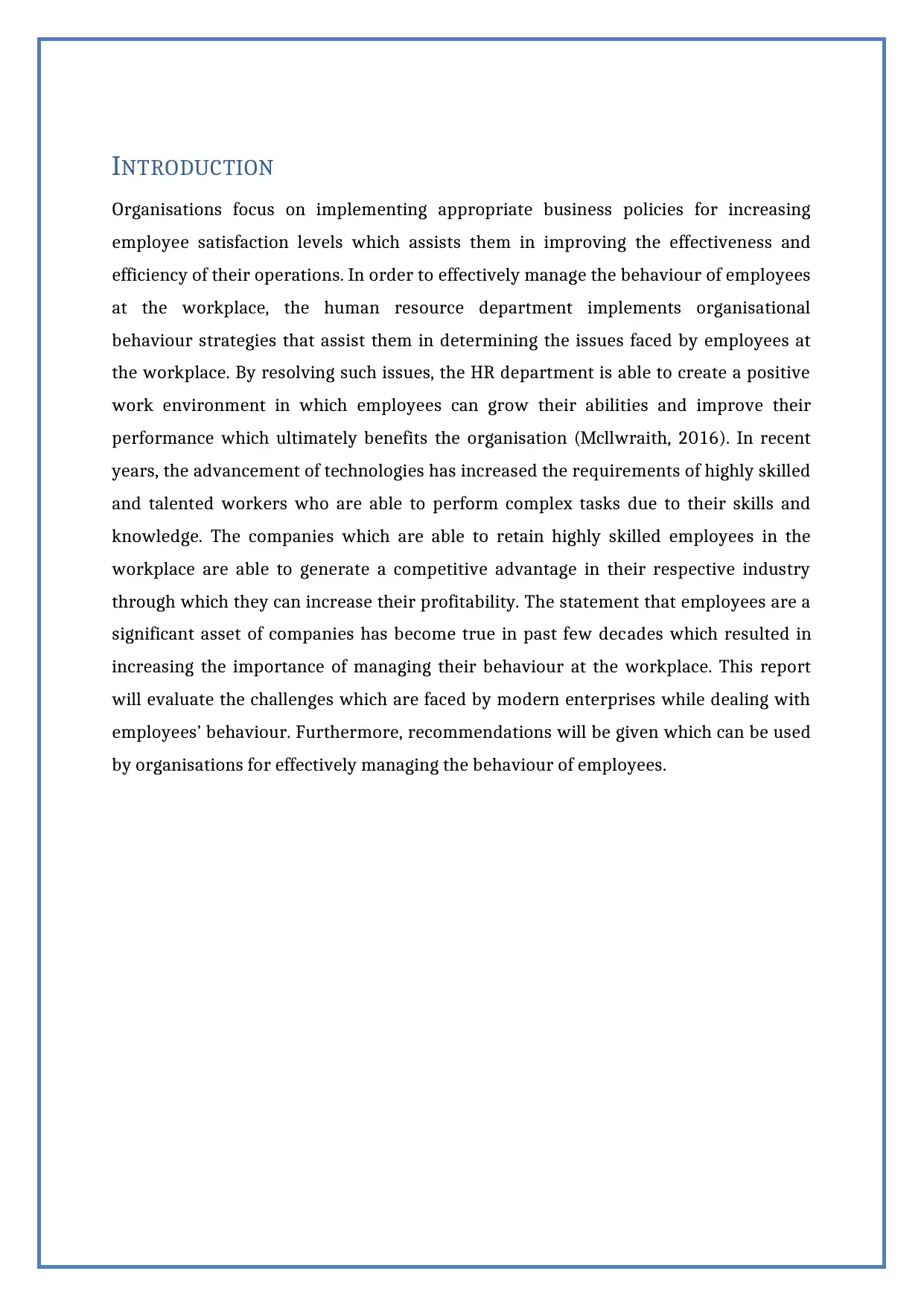
INTRODUCTION
Organisations focus on implementing appropriate business policies for increasing
employee satisfaction levels which assists them in improving the effectiveness and
efficiency of their operations. In order to effectively manage the behaviour of employees
at the workplace, the human resource department implements organisational
behaviour strategies that assist them in determining the issues faced by employees at
the workplace. By resolving such issues, the HR department is able to create a positive
work environment in which employees can grow their abilities and improve their
performance which ultimately benefits the organisation (Mcllwraith, 2016). In recent
years, the advancement of technologies has increased the requirements of highly skilled
and talented workers who are able to perform complex tasks due to their skills and
knowledge. The companies which are able to retain highly skilled employees in the
workplace are able to generate a competitive advantage in their respective industry
through which they can increase their profitability. The statement that employees are a
significant asset of companies has become true in past few decades which resulted in
increasing the importance of managing their behaviour at the workplace. This report
will evaluate the challenges which are faced by modern enterprises while dealing with
employees’ behaviour. Furthermore, recommendations will be given which can be used
by organisations for effectively managing the behaviour of employees.
Organisations focus on implementing appropriate business policies for increasing
employee satisfaction levels which assists them in improving the effectiveness and
efficiency of their operations. In order to effectively manage the behaviour of employees
at the workplace, the human resource department implements organisational
behaviour strategies that assist them in determining the issues faced by employees at
the workplace. By resolving such issues, the HR department is able to create a positive
work environment in which employees can grow their abilities and improve their
performance which ultimately benefits the organisation (Mcllwraith, 2016). In recent
years, the advancement of technologies has increased the requirements of highly skilled
and talented workers who are able to perform complex tasks due to their skills and
knowledge. The companies which are able to retain highly skilled employees in the
workplace are able to generate a competitive advantage in their respective industry
through which they can increase their profitability. The statement that employees are a
significant asset of companies has become true in past few decades which resulted in
increasing the importance of managing their behaviour at the workplace. This report
will evaluate the challenges which are faced by modern enterprises while dealing with
employees’ behaviour. Furthermore, recommendations will be given which can be used
by organisations for effectively managing the behaviour of employees.
⊘ This is a preview!⊘
Do you want full access?
Subscribe today to unlock all pages.

Trusted by 1+ million students worldwide

CHALLENGES IN MANAGING EMPLOYEE BEHAVIOUR
Employee behaviour is referred to the way in which a specific employee or a group of
employees responds to particular situations or circumstances in an organisation. There
are a number of elements which determines the behaviour of employees at the
workplace; however, these elements are generally affected by the cultural background
of employees or the organisational culture. The corporate culture in which employees
work or their personal cultures have a significant impact on the way how people
communicate and interact with others in the workplace (Albrecht et al., 2015). It also
influences the interactions between the management and employees at the workplace.
Additionally, the ethical beliefs or sense of ethical responsibility plays a crucial role in
influencing the behaviour of an employee at a workplace. Based on these factors, it can
be seen that there are two ways of managing employee behaviour which include
influencing personal and organisational culture. It is not possible for the management to
influence the personal culture of an employee because each individual comes from a
different background which affects their behaviour in the workplace. However, the
management can influence the organisational culture which is a key factor that affects
the behaviour of employees at the workplace (Mowday, Porter and Steers, 2013).
Therefore, the HR department focuses on implementing appropriate business policies
for establishing a positive work environment which positively affects the behaviour of
employees as well.
While influencing the organisational culture or managing the behaviour of employees,
there are a number of issues faced by the management which made it difficult for them
to establish a positive working environment. One of the major challenges faced by the
management in modern organisations is stereotyping at the workplace. A stereotype is
referred to a fixed image of a person or group of people’s characteristics which is
usually an oversimplified or exaggerated image of their attributes. Due to globalisation
and digitalisation, the number of foreign workers operating in international
corporations has grown substantially. The HR department faces new challenges because
they have to manage people from different cultural backgrounds, races, religion and
gender (Young et al., 2015). Due to racism and casteism, people who belong to
minorities or different cultural backgrounds face difficulties at the workplace. They are
Employee behaviour is referred to the way in which a specific employee or a group of
employees responds to particular situations or circumstances in an organisation. There
are a number of elements which determines the behaviour of employees at the
workplace; however, these elements are generally affected by the cultural background
of employees or the organisational culture. The corporate culture in which employees
work or their personal cultures have a significant impact on the way how people
communicate and interact with others in the workplace (Albrecht et al., 2015). It also
influences the interactions between the management and employees at the workplace.
Additionally, the ethical beliefs or sense of ethical responsibility plays a crucial role in
influencing the behaviour of an employee at a workplace. Based on these factors, it can
be seen that there are two ways of managing employee behaviour which include
influencing personal and organisational culture. It is not possible for the management to
influence the personal culture of an employee because each individual comes from a
different background which affects their behaviour in the workplace. However, the
management can influence the organisational culture which is a key factor that affects
the behaviour of employees at the workplace (Mowday, Porter and Steers, 2013).
Therefore, the HR department focuses on implementing appropriate business policies
for establishing a positive work environment which positively affects the behaviour of
employees as well.
While influencing the organisational culture or managing the behaviour of employees,
there are a number of issues faced by the management which made it difficult for them
to establish a positive working environment. One of the major challenges faced by the
management in modern organisations is stereotyping at the workplace. A stereotype is
referred to a fixed image of a person or group of people’s characteristics which is
usually an oversimplified or exaggerated image of their attributes. Due to globalisation
and digitalisation, the number of foreign workers operating in international
corporations has grown substantially. The HR department faces new challenges because
they have to manage people from different cultural backgrounds, races, religion and
gender (Young et al., 2015). Due to racism and casteism, people who belong to
minorities or different cultural backgrounds face difficulties at the workplace. They are
Paraphrase This Document
Need a fresh take? Get an instant paraphrase of this document with our AI Paraphraser
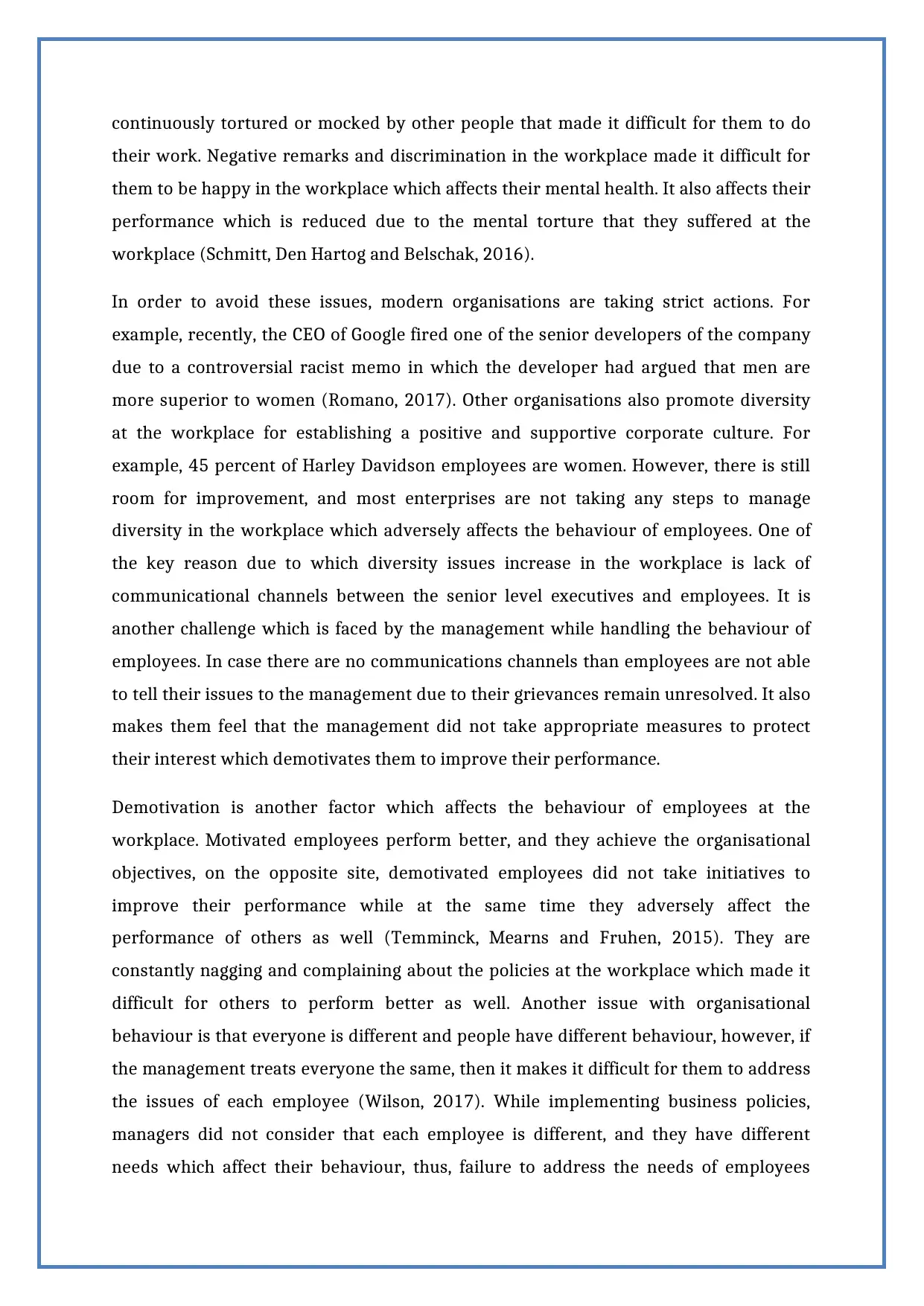
continuously tortured or mocked by other people that made it difficult for them to do
their work. Negative remarks and discrimination in the workplace made it difficult for
them to be happy in the workplace which affects their mental health. It also affects their
performance which is reduced due to the mental torture that they suffered at the
workplace (Schmitt, Den Hartog and Belschak, 2016).
In order to avoid these issues, modern organisations are taking strict actions. For
example, recently, the CEO of Google fired one of the senior developers of the company
due to a controversial racist memo in which the developer had argued that men are
more superior to women (Romano, 2017). Other organisations also promote diversity
at the workplace for establishing a positive and supportive corporate culture. For
example, 45 percent of Harley Davidson employees are women. However, there is still
room for improvement, and most enterprises are not taking any steps to manage
diversity in the workplace which adversely affects the behaviour of employees. One of
the key reason due to which diversity issues increase in the workplace is lack of
communicational channels between the senior level executives and employees. It is
another challenge which is faced by the management while handling the behaviour of
employees. In case there are no communications channels than employees are not able
to tell their issues to the management due to their grievances remain unresolved. It also
makes them feel that the management did not take appropriate measures to protect
their interest which demotivates them to improve their performance.
Demotivation is another factor which affects the behaviour of employees at the
workplace. Motivated employees perform better, and they achieve the organisational
objectives, on the opposite site, demotivated employees did not take initiatives to
improve their performance while at the same time they adversely affect the
performance of others as well (Temminck, Mearns and Fruhen, 2015). They are
constantly nagging and complaining about the policies at the workplace which made it
difficult for others to perform better as well. Another issue with organisational
behaviour is that everyone is different and people have different behaviour, however, if
the management treats everyone the same, then it makes it difficult for them to address
the issues of each employee (Wilson, 2017). While implementing business policies,
managers did not consider that each employee is different, and they have different
needs which affect their behaviour, thus, failure to address the needs of employees
their work. Negative remarks and discrimination in the workplace made it difficult for
them to be happy in the workplace which affects their mental health. It also affects their
performance which is reduced due to the mental torture that they suffered at the
workplace (Schmitt, Den Hartog and Belschak, 2016).
In order to avoid these issues, modern organisations are taking strict actions. For
example, recently, the CEO of Google fired one of the senior developers of the company
due to a controversial racist memo in which the developer had argued that men are
more superior to women (Romano, 2017). Other organisations also promote diversity
at the workplace for establishing a positive and supportive corporate culture. For
example, 45 percent of Harley Davidson employees are women. However, there is still
room for improvement, and most enterprises are not taking any steps to manage
diversity in the workplace which adversely affects the behaviour of employees. One of
the key reason due to which diversity issues increase in the workplace is lack of
communicational channels between the senior level executives and employees. It is
another challenge which is faced by the management while handling the behaviour of
employees. In case there are no communications channels than employees are not able
to tell their issues to the management due to their grievances remain unresolved. It also
makes them feel that the management did not take appropriate measures to protect
their interest which demotivates them to improve their performance.
Demotivation is another factor which affects the behaviour of employees at the
workplace. Motivated employees perform better, and they achieve the organisational
objectives, on the opposite site, demotivated employees did not take initiatives to
improve their performance while at the same time they adversely affect the
performance of others as well (Temminck, Mearns and Fruhen, 2015). They are
constantly nagging and complaining about the policies at the workplace which made it
difficult for others to perform better as well. Another issue with organisational
behaviour is that everyone is different and people have different behaviour, however, if
the management treats everyone the same, then it makes it difficult for them to address
the issues of each employee (Wilson, 2017). While implementing business policies,
managers did not consider that each employee is different, and they have different
needs which affect their behaviour, thus, failure to address the needs of employees
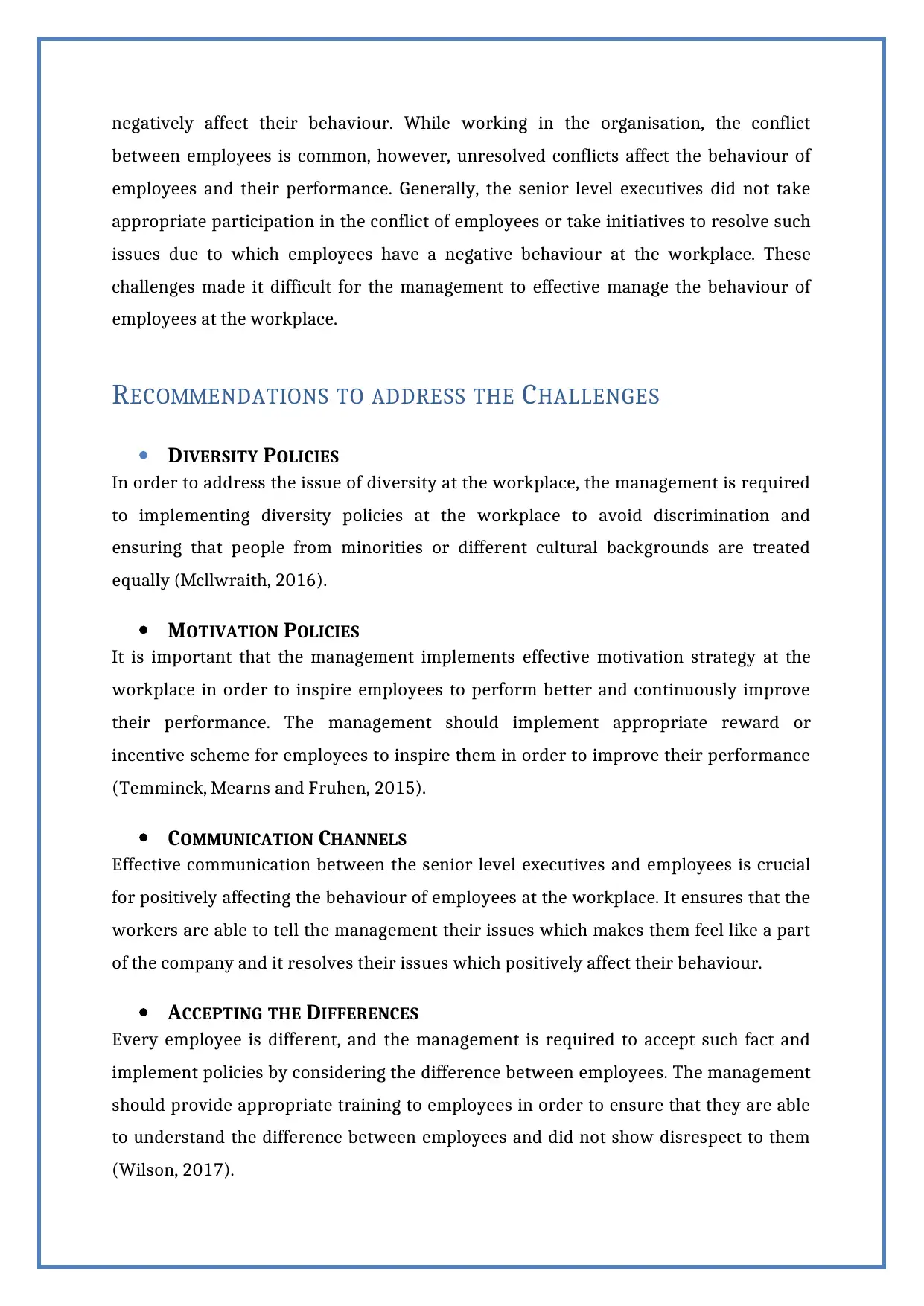
negatively affect their behaviour. While working in the organisation, the conflict
between employees is common, however, unresolved conflicts affect the behaviour of
employees and their performance. Generally, the senior level executives did not take
appropriate participation in the conflict of employees or take initiatives to resolve such
issues due to which employees have a negative behaviour at the workplace. These
challenges made it difficult for the management to effective manage the behaviour of
employees at the workplace.
RECOMMENDATIONS TO ADDRESS THE CHALLENGES
DIVERSITY POLICIES
In order to address the issue of diversity at the workplace, the management is required
to implementing diversity policies at the workplace to avoid discrimination and
ensuring that people from minorities or different cultural backgrounds are treated
equally (Mcllwraith, 2016).
MOTIVATION POLICIES
It is important that the management implements effective motivation strategy at the
workplace in order to inspire employees to perform better and continuously improve
their performance. The management should implement appropriate reward or
incentive scheme for employees to inspire them in order to improve their performance
(Temminck, Mearns and Fruhen, 2015).
COMMUNICATION CHANNELS
Effective communication between the senior level executives and employees is crucial
for positively affecting the behaviour of employees at the workplace. It ensures that the
workers are able to tell the management their issues which makes them feel like a part
of the company and it resolves their issues which positively affect their behaviour.
ACCEPTING THE DIFFERENCES
Every employee is different, and the management is required to accept such fact and
implement policies by considering the difference between employees. The management
should provide appropriate training to employees in order to ensure that they are able
to understand the difference between employees and did not show disrespect to them
(Wilson, 2017).
between employees is common, however, unresolved conflicts affect the behaviour of
employees and their performance. Generally, the senior level executives did not take
appropriate participation in the conflict of employees or take initiatives to resolve such
issues due to which employees have a negative behaviour at the workplace. These
challenges made it difficult for the management to effective manage the behaviour of
employees at the workplace.
RECOMMENDATIONS TO ADDRESS THE CHALLENGES
DIVERSITY POLICIES
In order to address the issue of diversity at the workplace, the management is required
to implementing diversity policies at the workplace to avoid discrimination and
ensuring that people from minorities or different cultural backgrounds are treated
equally (Mcllwraith, 2016).
MOTIVATION POLICIES
It is important that the management implements effective motivation strategy at the
workplace in order to inspire employees to perform better and continuously improve
their performance. The management should implement appropriate reward or
incentive scheme for employees to inspire them in order to improve their performance
(Temminck, Mearns and Fruhen, 2015).
COMMUNICATION CHANNELS
Effective communication between the senior level executives and employees is crucial
for positively affecting the behaviour of employees at the workplace. It ensures that the
workers are able to tell the management their issues which makes them feel like a part
of the company and it resolves their issues which positively affect their behaviour.
ACCEPTING THE DIFFERENCES
Every employee is different, and the management is required to accept such fact and
implement policies by considering the difference between employees. The management
should provide appropriate training to employees in order to ensure that they are able
to understand the difference between employees and did not show disrespect to them
(Wilson, 2017).
⊘ This is a preview!⊘
Do you want full access?
Subscribe today to unlock all pages.

Trusted by 1+ million students worldwide
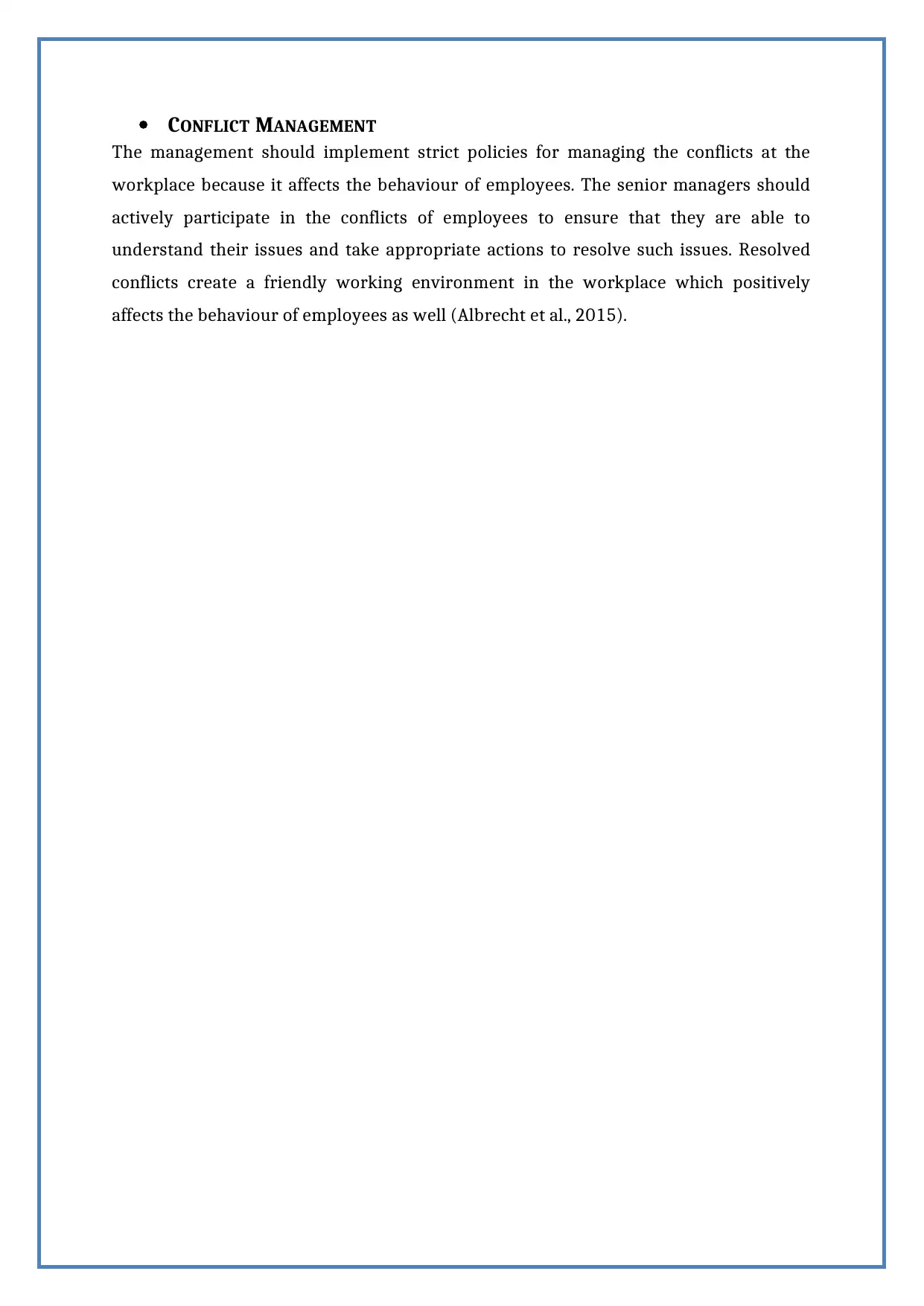
CONFLICT MANAGEMENT
The management should implement strict policies for managing the conflicts at the
workplace because it affects the behaviour of employees. The senior managers should
actively participate in the conflicts of employees to ensure that they are able to
understand their issues and take appropriate actions to resolve such issues. Resolved
conflicts create a friendly working environment in the workplace which positively
affects the behaviour of employees as well (Albrecht et al., 2015).
The management should implement strict policies for managing the conflicts at the
workplace because it affects the behaviour of employees. The senior managers should
actively participate in the conflicts of employees to ensure that they are able to
understand their issues and take appropriate actions to resolve such issues. Resolved
conflicts create a friendly working environment in the workplace which positively
affects the behaviour of employees as well (Albrecht et al., 2015).
Paraphrase This Document
Need a fresh take? Get an instant paraphrase of this document with our AI Paraphraser
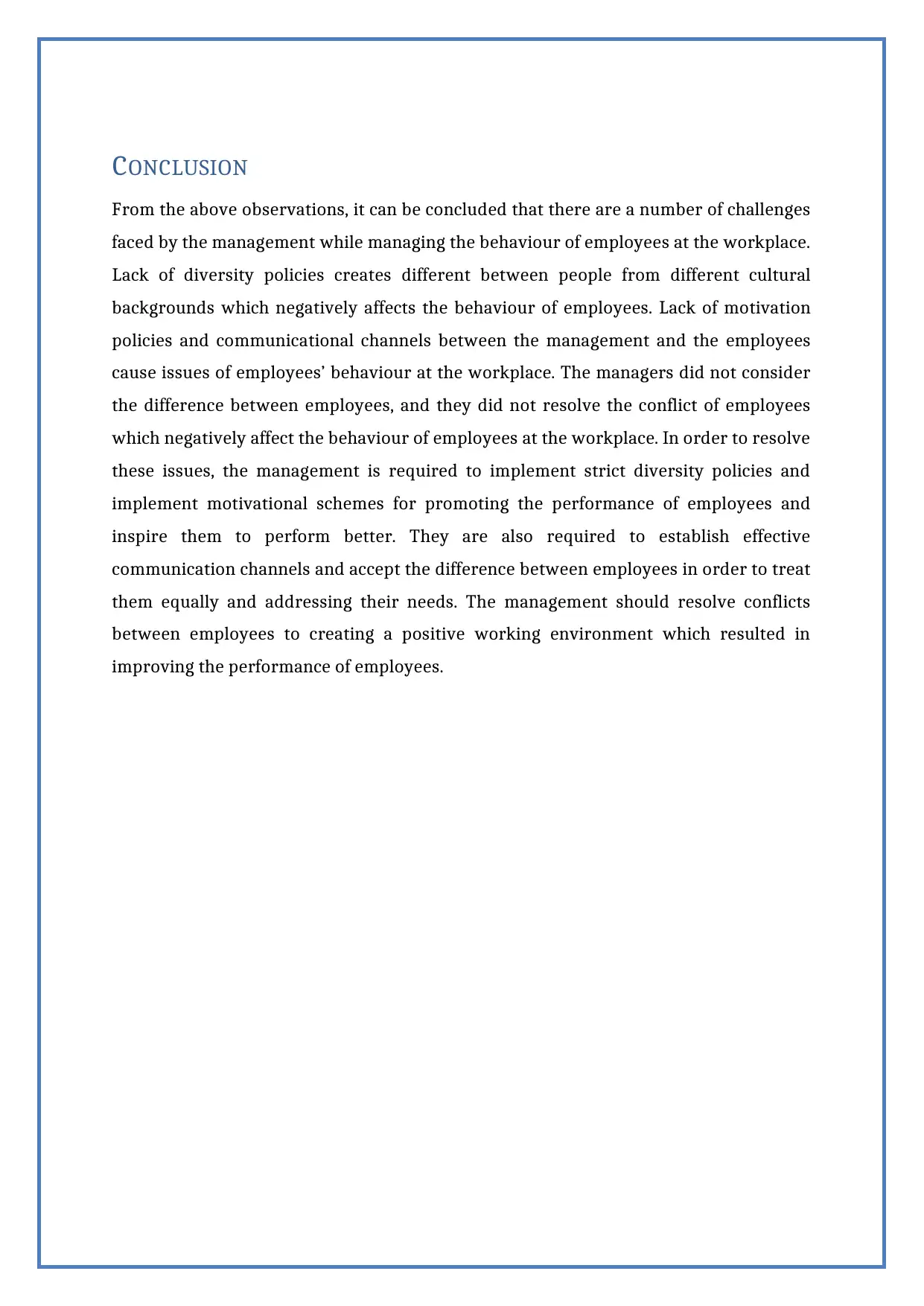
CONCLUSION
From the above observations, it can be concluded that there are a number of challenges
faced by the management while managing the behaviour of employees at the workplace.
Lack of diversity policies creates different between people from different cultural
backgrounds which negatively affects the behaviour of employees. Lack of motivation
policies and communicational channels between the management and the employees
cause issues of employees’ behaviour at the workplace. The managers did not consider
the difference between employees, and they did not resolve the conflict of employees
which negatively affect the behaviour of employees at the workplace. In order to resolve
these issues, the management is required to implement strict diversity policies and
implement motivational schemes for promoting the performance of employees and
inspire them to perform better. They are also required to establish effective
communication channels and accept the difference between employees in order to treat
them equally and addressing their needs. The management should resolve conflicts
between employees to creating a positive working environment which resulted in
improving the performance of employees.
From the above observations, it can be concluded that there are a number of challenges
faced by the management while managing the behaviour of employees at the workplace.
Lack of diversity policies creates different between people from different cultural
backgrounds which negatively affects the behaviour of employees. Lack of motivation
policies and communicational channels between the management and the employees
cause issues of employees’ behaviour at the workplace. The managers did not consider
the difference between employees, and they did not resolve the conflict of employees
which negatively affect the behaviour of employees at the workplace. In order to resolve
these issues, the management is required to implement strict diversity policies and
implement motivational schemes for promoting the performance of employees and
inspire them to perform better. They are also required to establish effective
communication channels and accept the difference between employees in order to treat
them equally and addressing their needs. The management should resolve conflicts
between employees to creating a positive working environment which resulted in
improving the performance of employees.
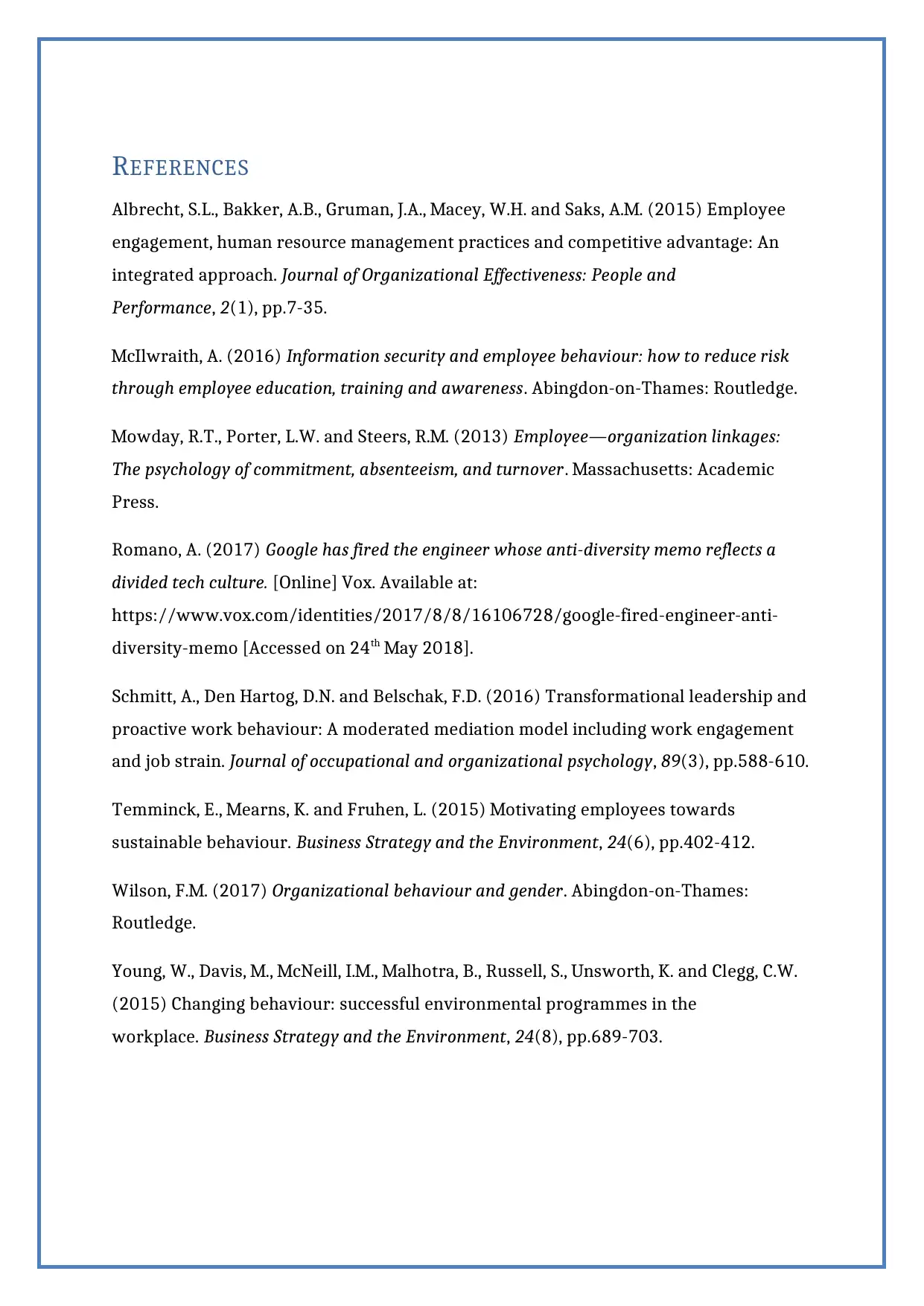
REFERENCES
Albrecht, S.L., Bakker, A.B., Gruman, J.A., Macey, W.H. and Saks, A.M. (2015) Employee
engagement, human resource management practices and competitive advantage: An
integrated approach. Journal of Organizational Effectiveness: People and
Performance, 2(1), pp.7-35.
McIlwraith, A. (2016) Information security and employee behaviour: how to reduce risk
through employee education, training and awareness. Abingdon-on-Thames: Routledge.
Mowday, R.T., Porter, L.W. and Steers, R.M. (2013) Employee—organization linkages:
The psychology of commitment, absenteeism, and turnover. Massachusetts: Academic
Press.
Romano, A. (2017) Google has fired the engineer whose anti-diversity memo reflects a
divided tech culture. [Online] Vox. Available at:
https://www.vox.com/identities/2017/8/8/16106728/google-fired-engineer-anti-
diversity-memo [Accessed on 24th May 2018].
Schmitt, A., Den Hartog, D.N. and Belschak, F.D. (2016) Transformational leadership and
proactive work behaviour: A moderated mediation model including work engagement
and job strain. Journal of occupational and organizational psychology, 89(3), pp.588-610.
Temminck, E., Mearns, K. and Fruhen, L. (2015) Motivating employees towards
sustainable behaviour. Business Strategy and the Environment, 24(6), pp.402-412.
Wilson, F.M. (2017) Organizational behaviour and gender. Abingdon-on-Thames:
Routledge.
Young, W., Davis, M., McNeill, I.M., Malhotra, B., Russell, S., Unsworth, K. and Clegg, C.W.
(2015) Changing behaviour: successful environmental programmes in the
workplace. Business Strategy and the Environment, 24(8), pp.689-703.
Albrecht, S.L., Bakker, A.B., Gruman, J.A., Macey, W.H. and Saks, A.M. (2015) Employee
engagement, human resource management practices and competitive advantage: An
integrated approach. Journal of Organizational Effectiveness: People and
Performance, 2(1), pp.7-35.
McIlwraith, A. (2016) Information security and employee behaviour: how to reduce risk
through employee education, training and awareness. Abingdon-on-Thames: Routledge.
Mowday, R.T., Porter, L.W. and Steers, R.M. (2013) Employee—organization linkages:
The psychology of commitment, absenteeism, and turnover. Massachusetts: Academic
Press.
Romano, A. (2017) Google has fired the engineer whose anti-diversity memo reflects a
divided tech culture. [Online] Vox. Available at:
https://www.vox.com/identities/2017/8/8/16106728/google-fired-engineer-anti-
diversity-memo [Accessed on 24th May 2018].
Schmitt, A., Den Hartog, D.N. and Belschak, F.D. (2016) Transformational leadership and
proactive work behaviour: A moderated mediation model including work engagement
and job strain. Journal of occupational and organizational psychology, 89(3), pp.588-610.
Temminck, E., Mearns, K. and Fruhen, L. (2015) Motivating employees towards
sustainable behaviour. Business Strategy and the Environment, 24(6), pp.402-412.
Wilson, F.M. (2017) Organizational behaviour and gender. Abingdon-on-Thames:
Routledge.
Young, W., Davis, M., McNeill, I.M., Malhotra, B., Russell, S., Unsworth, K. and Clegg, C.W.
(2015) Changing behaviour: successful environmental programmes in the
workplace. Business Strategy and the Environment, 24(8), pp.689-703.
⊘ This is a preview!⊘
Do you want full access?
Subscribe today to unlock all pages.

Trusted by 1+ million students worldwide
1 out of 9
Related Documents
Your All-in-One AI-Powered Toolkit for Academic Success.
+13062052269
info@desklib.com
Available 24*7 on WhatsApp / Email
![[object Object]](/_next/static/media/star-bottom.7253800d.svg)
Unlock your academic potential
Copyright © 2020–2025 A2Z Services. All Rights Reserved. Developed and managed by ZUCOL.




